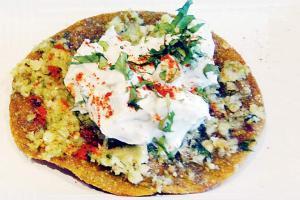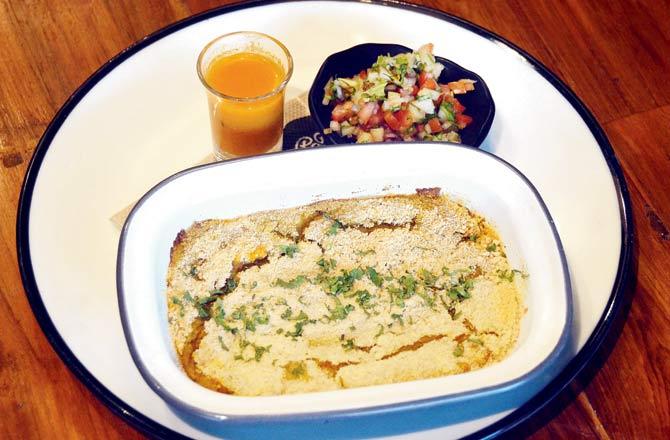A new Maharashtrian pop-up hopes to demystify the cuisine. We find out what it takes for regional to go global

Pan-roasted thalipeeth topped with spicy thecha and guava and yoghurt salsa
It's a busy morning inside the sprawling open kitchen at Chembur's Pot Pourri with blogger-author Saee Koranne-Khandekar helming the activity with help from executive chef Vinod Garde. In the last 10 days she has been pretty much relegated to this section of the 175-seater space. The only time we see her stepping out is to answer a phone call or greet a guest. The reason is a new culinary experiment that will see the restaurant, known for dabbling in global cuisine, present a new face of Maharashtrian food. One that you might not identify by its appearance — we did not — but certainly by taste.

Chicken Bhujing is a street dish available inVirar. Bhujing, derived from the Marathi word, bhujne, is a process of roasting chicken with potatoes on charcoal and then mixing it with nylon poha and masalas
ADVERTISEMENT
Creating a new avatar
Starting today, Pot Pourri will roll out a new menu curated by Khandekar that will be available only till October 24. The objective is to showcase how traditional Maharashtrian recipes can be tweaked and made palatable to an evolving audience, who might otherwise gawk at the idea of eating faraali misal or varan phala at a gourmet restaurant. Having said that, Khandekar is clear that food won't carry any 'deconstructivist' baggage. Portion sizes are hearty, and there are no foam, vapours and gasses to accompany it.

Pathare Prabhu pot pie with tomato saar
"I had to mainly work on the way I approached certain traditional dishes," says Khandekar, who in 2016, authored Crumbs! Bread Stories and Recipes for the Indian Kitchen, that offered more than 40 recipes of Indian and international breads. She adds, "For instance, if I said thalipeeth with koshimbir, people who are not familiar with the cuisine, might say, 'Oh, this is just too experimental for me'. They might find it intimidating and rustic, and not want to eat it at all." In order to give the spiced Maharashtrian pancake a makeover, Khandekar has created thalipeeth tostadas, topped with a creamy guava-based yoghurt salad. The dish, prepared using bhajanee (flour made from roasted grains, legumes and spices), has been fashioned to look like the Mexican tortilla with guacamole. If you have tasted the Maharashtrian snack, a powerhouse of nutrition, the taste will hit home. It's the yoghurt that helps balance the spiciness of the pancake, making it a sumptuous bar snack.

Faraali misal is eaten while fasting. Here's it's served with a peanut dip
Khandekar believes that although, thalipeeth has for centuries been a 'multigrain' offering, the idea of bringing into the mainstream never took off due to its seemingly regional strappings. "Somewhere, in the name of 'evolution', we have drifted away from what's intrinsic to the culture. Our cuisine which was earlier very millet and rice-heavy has now moved to being wheat heavy. Seasonal items like gourds barely make an appearance," she adds.

Modak icecrean with crispy vermicelli; Baked coconut fudge karanji with vanilla icecream
Getting global recognition
For any regional cuisine to reach the pedestal of a fine dine, it needs to go through a rite of passage, believes Rajendra Agnihotri, executive chef, at White Charcoal Fine Dine, Empressa Hotel, Andheri. "In terms of food, the key lies in the attention to detail when it comes to ingredients and methods of preparation. The ingredients need to be sourced from where it originates and the chefs need to be local who have specialised in the cuisine; it has to be authentic to the T. If you're making the classic kombdi rassa, you would need gavthi chicken. The one purchased from a supermarket won't have the same taste," he says. When it comes to Maharashtrian cuisine, it's the diversity that makes it complex. In fact, the vegetable Kolhapuri that you might have seen on almost every Indian restaurant's menu doesn't exist in the region, adds Khandekar.

Saee Koranne-Khandekar with chef Vinod Garde. Pics/Sayyed Sameer Abedi
"There is nothing called as Veg Kolhapuri. If you go to Kolhapur, there are so many different masalas. There's no one-size-fits all masala." Akshay Deshpande, Sous Chef (Indian specialty), Conrad Pune, who grew up eating Maharashtrian food at home, admits that he's seen little of the food on the fine dine space. "It has been over eight years that I have taken up regional cooking professionally, but I admit that the cuisine in its entirety is an extremely unexplored cuisine. I think it's because it's extremely rustic and there's no standardisation so to speak," he says.
The cuisine from Vidharbha, the north-eastern region of Maharashtra, known for its extreme climates, is famous for its extremely spicy flavours, while Konkan is more mellow given all the coconut and kokum that goes into it. According to Khanderkar, who has extensively researched traditional Maharastrian cuisine, what has made winners out of misal pav and puranpoli, are the people who migrated from Western Maharashtra, introducing it to Mumbai through khanavals. "They made a business out of it and that's why it is what it is," she says. But those dishes that did not transition to the mainland, are yet to enjoy their moment in the sun.
Back to basics
The 'unsophisticated' appearance makes it a tricky business. She, for one, had to battle one critic in her own home. "My husband was of the opinion that Maharashtrian food is not visually appetising," she says. But chefs are now channelling their energies into presentation. The modernist element is consistent throughout Khandekar's menu. Take the Pathare Prabhu Pot Pie with tomato saar, served in a shot glass. The latter is a spicy tomato soup made with curry leaves and chillies. It's eaten with rice in parts of Maharashtra and Karnataka. Here, the dish is a take on the shepherd pie. The taste is unmistakably Pathare Prabhu, courtesy the signature fragrant garam masala which gets its edge from the fennel seeds that are ground along with Bengal gram, fenugreek, whole wheat and black peppercorn. All ingredients, we are told, have been sourced locally.
Agnihotri feels the local and regional cuisines are slowly making their way into the mainstream. And, it's a lot to do with the growing realisation of the food miles concept, which is a way of expressing just how far the food we eat travels from the farm where it is first produced, before it ends up on our tables. Although the expression was first coined back in the 1990s, it has entered public consciousness given the awareness of carbon footprint and environmental degradation. "You want to tap into indigenous resources. It's to do with chefs who are going back to roots. There's a return to basics," he says.
The winners
- Chicken Bhujing, a signature street dish popular in the confines of Virar and Vasai. Those living outside the parameters may have no clue. The chicken is roasted along with potatoes and then fried and steamed with onion. It's then mixed with nylon poha and a special masala mix
- Orange kharvas with dink crumb and kaakvi is a colostrum pudding served with fried edible gum, fresh orange and sugarcane molasses
- Varan Phala Ravioli is their take on the Maharashtrian pasta. It is made with whole wheat and stuffed with coriander and goda masala in a tuar dal sauce
Catch up on all the latest Mumbai news, crime news, current affairs, and also a complete guide on Mumbai from food to things to do and events across the city here. Also download the new mid-day Android and iOS apps to get latest updates
 Subscribe today by clicking the link and stay updated with the latest news!" Click here!
Subscribe today by clicking the link and stay updated with the latest news!" Click here!







